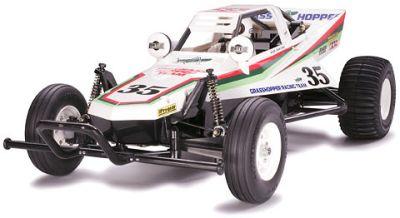Jimminy Mother-Whoring Christmas, Charlie.

That’s all I want to know. Tamiya, an early leader in RC technology re-released the Grasshopper and the Hornet (the Grasshopper’s “souped up” cousin), two classic scale buggies whose heyday came and went in the mid-80s. For the life of me, I can’t figure out why they did it.
The Grasshopper was the first RC car I ever had. It’s also the only 1/10 scale car I’ve ever heard of that came with a 380-size motor instead of the standard 540. Not only that, but instead of having a thin polycarbonate body shell, it had a thick, hard plastic one that didn’t flex and weighed about 400 lbs. It featured spring-only shocks that bottomed out on every bump, and while the front two were independent, the rear suspension was of the single-axle trailing arm type (which means that every time you hit a bump, both rear wheels go flying). In retrospect, I’m amazed it even had a diff. It was a piece of shit, alright, but I sure loved it. Then I drove it into the ocean and it died. But I digress.
Nowadays, any decent mid-range RC car is a wildly over-engineered speed machine made primarily of titanium, graphite, and carbon fiber. It might feature a carbide ball diff, a coreless, brushless cobalt/rare-earth motor, and a lithium polymer battery that is half the weight of the old NiCd’s with 4x the specific energy. And the idea that shocks would be (a) not fully independent (except on a 1/12 pan car), and (b) not oil-filled, is angeringly absurd.

The question is no longer even whether to use oil dampers, but rather what oil weight to use in the front and back, given the track conditions. The last time anyone seriously considered using spring shocks alone on a 1/10 scale car was when Reagan was president.
The thing about scale—and not just cars—is that fanatics will go to almost any lengths to build to the current technological potential. That’s why these divorced engineers show up at the track with $2500 RC cars stored in the back of their $1500 hatchbacks. Long before LiPoly batteries showed up in cell phones, they were being jury-rigged into RC planes and cars. Almost as soon as the prototypical wireless video technology allowed it, nitro fiends were rigging up systems in their planes. Any self-respecting Nitromaniac will spend dozens and dozens of hours per vehicle tinkering with the minutest of control settings, and every year the RC community builds astoundingly hi-tech new vehicles.
Oddly, the company that probably did the most to bring “serious” RC cars to the masses, Tamiya, consistently has lagged the industry for years now. Their cars are heavy, inefficient, made of cheap materials, and amateurishly designed. Of all the major brands, which include Losi, Team Associated, Kyosho, HPI, Mugen Seiki, Ofna, and others, Tamiya is by far the least competitive.
All of which makes one wonder why in Christ’s holy name they re-released the Grasshopper and the Hornet. Like any committed Nitro fiend, I’m nostalgic about my old Grasshopper: the nerf bars, the paddle tires--all that shit. But for $85 (retail), why would anyone ever consider buying a scale car featuring 1984 technology? I just don’t get it. It’s literally like re-releasing the Atari 2600 and pricing it a hair lower than an Xbox 360.
Maybe Tamiya is fresh out of design ideas, I don’t know. On the other hand, they have come out with at least one unique whip. Granted, it’s a scale 1977 Tyrrell P34 F1 car, but given that it has 4 steerable front wheels (like the original), you have to give it props.

I’ll leave you with a link to a video of this guy who built a flame thrower into his Traxxas T-Maxx nitro monster truck. It’s effing awesome:
http://videos.radiocontrolzone.com/hotshot2.ZIP
Also, here’s a HPI Super Nitro RS4 that does 100MPH:
http://videos.radiocontrolzone.com/100mphcwh.zip
Tons more here: http://www.radiocontrolzone.com/cars/video.asp

















0 Comments:
Post a Comment
<< Home